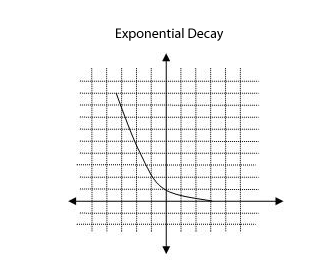 username@email.com
username@email.com
In this lesson, you will study the standard form of an exponential function and behavior of growth and decay in functions. You will also review how to solve equations in exponential form (the variable in the equation is located in the exponent).
The basic form of an exponential function is
![]() .
.
The variables are defined as:
When b > 1, the function has exponential growth. An example of a growth function model is ![]() . This example is graphed below.
. This example is graphed below.

When 0 < b < 1, the function has exponential decay. An example of a decay function model is  . This example is graphed below.
. This example is graphed below.

Which equation models exponential decay?
The correct choice is B. For a function to decay, the base is between 0 > b > 1. Choice B has a base of 0.75.
The equation for compound interest is an excellent example of exponential growth. It is given by  , where P = principle, r = interest rate, n = compounding periods per year, t = time, and A = final amount.
, where P = principle, r = interest rate, n = compounding periods per year, t = time, and A = final amount.
An initial investment of $5,000.00, compounded yearly at an interest rate of 15%, will be worth what amount in 20 years?
The correct choice is D. The interest rate, in decimal form, is r = 0.15. Compounding is yearly, therefore n = 1. The duration is t = 20 years.
![]()
To solve exponential functions, we must first introduce the concept of logarithms. The definition of a logarithm is
![]() .
.
Logarithms are very useful in solving exponential equations. Using logarithms, we now have a way to transfer the variable x out of the exponential position. This allows us to solve the equation.
Let’s try an example. Write the exponential equation ![]() in logarithmic form.
in logarithmic form.
Step 1: Notice the position of each number and the variable x in the exponential equation.
![]()
Step 2: Rewrite using the logarithmic equation.
![]()
Bases of logarithms can be any positive number. The most common base is 10, and
logarithms with a base 10 are called common logarithms. If a base is not identified, it is assumed to be 10.
Addition Property
![]()
Subtraction Property
![]()
Power Property
![]()
When working with logarithms, it is often desirable to convert from one base to another. Frequently, we will want to convert to base 10. Many calculators only evaluate logarithms for base 10; therefore, we have to make the conversion before using the calculator to solve. The conversion, or change of base, formula is  , where b = the existing base, a = the new base, and q = a positive number. Let’s try an example. Convert
, where b = the existing base, a = the new base, and q = a positive number. Let’s try an example. Convert ![]() to base 10 and evaluate.
to base 10 and evaluate.
Step 1: In this problem, b = 4, a = 10, and q = 8.
Step 2: Use the change of base formula.
![]()
In order to solve an exponential equation, we must first isolate the variable located in the exponent. Once isolated, we can solve the equation.
Remember to use the relationship between exponential equations and logarithmic
equations: ![]() .
.
For example, solve ![]() .
.
Step 1: Recognize that this is an exponential equation, with base 3. Convert to logarithmic form.
![]()
Step 2: Convert from base 3 to base 10.
![]()
Step 3: Solve for x.
![]()
Let’s try another example. Solve ![]() .
.
Step 1: Recognize that this is a logarithmic equation, with base 2. Convert to exponential form.
![]()
Step 2: Solve for x.

Algebra Demystified: A Self-teaching Guide (Rhonda Huettenmueller): McGraw-Hill, 2003.
College Algebra (Ron Larson and Robert P. Hostetler): Houghton Mifflin, 2003.
Practical Algebra: A Self-Teaching Guide (Peter H. Selby and Steve Slavin): John Wiley and Sons, 1991.
Schaum’s Outline of Intermediate Algebra (Ray Steege and Kerry Bailey): McGraw Hill, 1997.
Don’t forget to test your knowledge with the Algebra and Functions II Chapter Quiz;